Fire extinguishers
A fire extinguisher is a basic portable fire protection device. Fire extinguishers have to meet specific requirements regarding their working order, technical condition, extinguishing technology. To keep a fire extinguisher in a working order and ensure fire safety, the device should be subject to periodic inspections of its technical condition.
Requirements for fire extinguishers in facilities
The principal document which guides the use of fire extinguishers is the Act of 24 August 1991 on fire protection (Journal of Laws of 2002 no. 147, item 147, as amended) which in article 3, section 1 states that: “A natural person, a legal person, an organization or an institution which uses an environment, an object, a building or an area is obliged to protect it against fire or other local hazard”. Section 2 of the same article states that: “an owner, a manager or a user of a building, an object or an area, as well as parties listed in section 1, are liable for the violation of fire safety regulations in a mode and on terms set forth in other regulations”. In Article 4, section 1 of the same Act there is a list of the obligations of such parties, which contains among others (point 2 and 3):
- providing required fire safety equipment and fire extinguishers in a building, structure or area,
- carrying out maintenance of fire safety equipment and fire extinguishers to ensure they are always in a working order.
According to the Regulation of the Minister of Internal Affairs and Administration of 21 April 2006 on fire safety in buildings, structures and areas it is stated in § 28, section 1 that fire extinguishers, with which the above mentioned facilities have to be equipped, have to meet the requirements of Polish standards (PN) which correspond to the European standards (EN). Appropriate extinguishers should be selected based on the class of fire which can occur at the facility. Section 2 contains the following list of fire classes:
Fire classes
| Class | Symbol | Description |
|---|---|---|
| A | 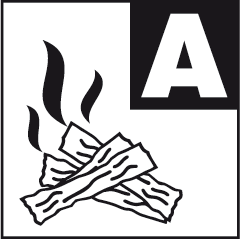 | fires which involve solids, usually of organic origin, whose burning involves a residue in the form of glowing ashes |
| B | 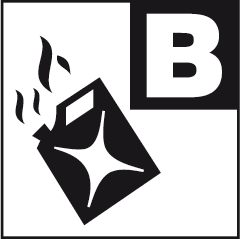 | fires which involve liquids and solids which melt |
| C | 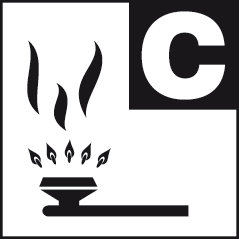 | fires which involve gases |
| D | 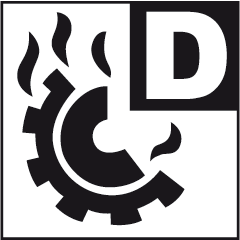 | fires which involve metals |
| F | 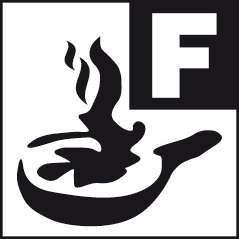 | fires which involve grease and oil from kitchen appliances. |
Types and marking of fire extinguishers
On-hand fire extinguishing equipment can be classified into two groups: handheld equipment and cart mounted equipment. A more accurate manner of classifying fire extinguishers is a division based on the type of extinguishing agent used and the fire classes presented in the table “Fire classes” for which the extinguisher is intended. Additonally, there is a division based on the location of the ejector.
According to the Polish standards:
- Fire extinguisher – a device which contains extinguishing agent which, as a result of the internal pressure, is discharged and directed at the fire. The pressure may be permanently stored in the vessel or created by a propellant gas.
- Handheld fire extinguisher – it is a fire extinguisher intended for manual carrying and use, whose weight in fully operational mode does not exceed 20kg.
- Cart mounted fire extinguisher (fire extinguishing wheeled unit) – it is a fire extinguisher for manual use and transport. It is mounted on a trolley and its weight in fully operational mode exceeds 20kg.
- Extinguishing agent – a substance inside a fire extinguisher which extinguishes fire.
- Extinguishing agent content – the weight or volume of extinguishing agent inside the fire extinguisher. The content is measured either in dm³ (e.g. foam solutions) or in kg.
- Discharge time – the time it takes for the extinguishing agent to be discharged if the valve is open, excluding the residue of propellant gas. The discharge time of particular fire extinguishers is presented in the table below.
| Extinguishing agent content [ kg lub dm3 ] | Minimum discharge time, [ s ] |
|---|---|
| less than 3 | 6 |
| from 3 to 6 | 9 |
| from 6 to 10 | 12 |
| more than 10 | 15 |
Based on the type of extinguishing agent, fire extinguishers are classified as: powder, foam or carbon dioxide extinguishers. Based on the intended use of fire extinguishers there are fire extinguishers for the following classes:
- AF solid materials whose combustion involves glowing embers and hot fats,
- AB solid materials whose combustion involves glowing embers and flammable liquids,
- BC flammable liquids and gases,
- ABC (versatile) solid materials whose combustion involves glowing embers, flammable liquids and gases,
- D (special) light metals.
Depending on the construction with respect to the location of propellant gas, there are two types of fire extinguishers:
- X – it means that the propellant gas and the extinguishing agent are in the same container. These extinguishers are under permanent pressure. The solution is employed in powder, foam and carbon dioxide extinguishers alike. The benefit of the solution is the fact that the fire extinguisher can be used immediately.
- Z – it means that the propellant gas and the extinguishing agent are located in separate containers. The extinguisher starts working after a few seconds of puncturing the membrane of gas cartridge.
A full description of fire extinguishers (applicable in Poland) contains letters and digits which mean as follows:
- G – fire extinguisher: P – powder; S – carbon dioxide; W, WG – foam;
- 1,2,4,6,9,… – the amount of extinguishing agent in kg or dm³
- X – constant pressure;
- Z – gas cartridge.
Additionally, some producers add their own symbols after a slash, e.g.: .../Z – fire extinguisher ze zbijakiem.
All fire extinguisher vessels should be painted red with a description label containing all necessary data in specific fields in the form of descriptions and symbols. The label contains the following data:
- field 1: name of the object (fire extinguisher), type and amount of extinguishing agent, information on fire classes and extinguishing capacity (the symbol of a test fire);
- field 2: manual instruction (one or more illustrations) and fire class pictograms denoting types of fires for which the extinguisher is intended;
- field 3: warning concerning intoxication and extinction of live electrical equipment (also the minimum distance required);
- field 4: information on the necessity to fill up the extinguisher after every use, recommendations on periodic inspections and maintenance in authorized service facilities, type of extinguishing agent, information on propellant agent, number or mark of certificate (certificate of approval for use), manufacturer’s marking, minimum and maximum temperature of operation, warranty period, freezing if required (water type fire extinguishers);
- field 5: name and address of the person responsible for the fire extinguisher.
- The information on the year of production can be placed anywhere on the vessel.
Minimum extinguishing capacity
Minimum extinguishing capacity is a parameter which determines the approximate size of fire which a given device is capable of extinguishing.
The parameter is defined according to PN-EN 3-7:2004+A1:2007 standard on the basis of a series of test fires for a given fire size (in a given fire class). Each series consists of three extinction attempts. If the fire extinguisher is successful at least two times, it is assumed that it has the right extinguishing capacity.
Characteristics of fire tests of A class fires according to PN-EN 3-7:2007
| Extinguishing capacity | Number of 500mm wood sticks in each transverse layer | Stack length, m |
|---|---|---|
| 5A | 5 | 0,5 |
| 8A | 8 | 0,8 |
| 13A | 13 | 1,3 |
| 21A | 21 | 2,1 |
| 27A | 27 | 2,7 |
| 34A | 34 | 3,4 |
| 43A | 43 | 4,3 |
| 55A | 55 | 5,5 |
Characteristics of fire tests of B class fires according to PN-EN 3-7:2004
| Extinguishing capacity | Liquid volume (1/3 water + 2/3 fuel, litres | Approximate fire area, m² | Minimum discharge time, s |
|---|---|---|---|
| 21B | 21 | 0,66 | 6 |
| 34B | 34 | 1,07 | 6 |
| 55B | 55 | 1,73 | 9 |
| 70B | 70 | 2,20 | 9 |
| 89B | 89 | 2,80 | 9 |
| 113B | 113 | 3,35 | 12 |
| 144B | 144 | 4,52 | 15 |
| 183B | 183 | 5,75 | 15 |
| 233B | 233 | 7,30 | 15 |
Characteristics of fire tests of F class fires according to PN-EN 3-7:2007
| Extinguishing capacity | Edible oil volume, litres | Nominal acceptable extinguishing agent content, litres | Minimum discharge time, s |
|---|---|---|---|
| 5F | 5 | 2, 3 | 6 |
| 25F | 25 | 2, 3, 6 | 9 |
| 40F | 40 | 2, 3, 6, 9 | 12 |
| 75F | 75 | 2, 3, 6, 9 | 15 |
The construction of the fire extinguisher
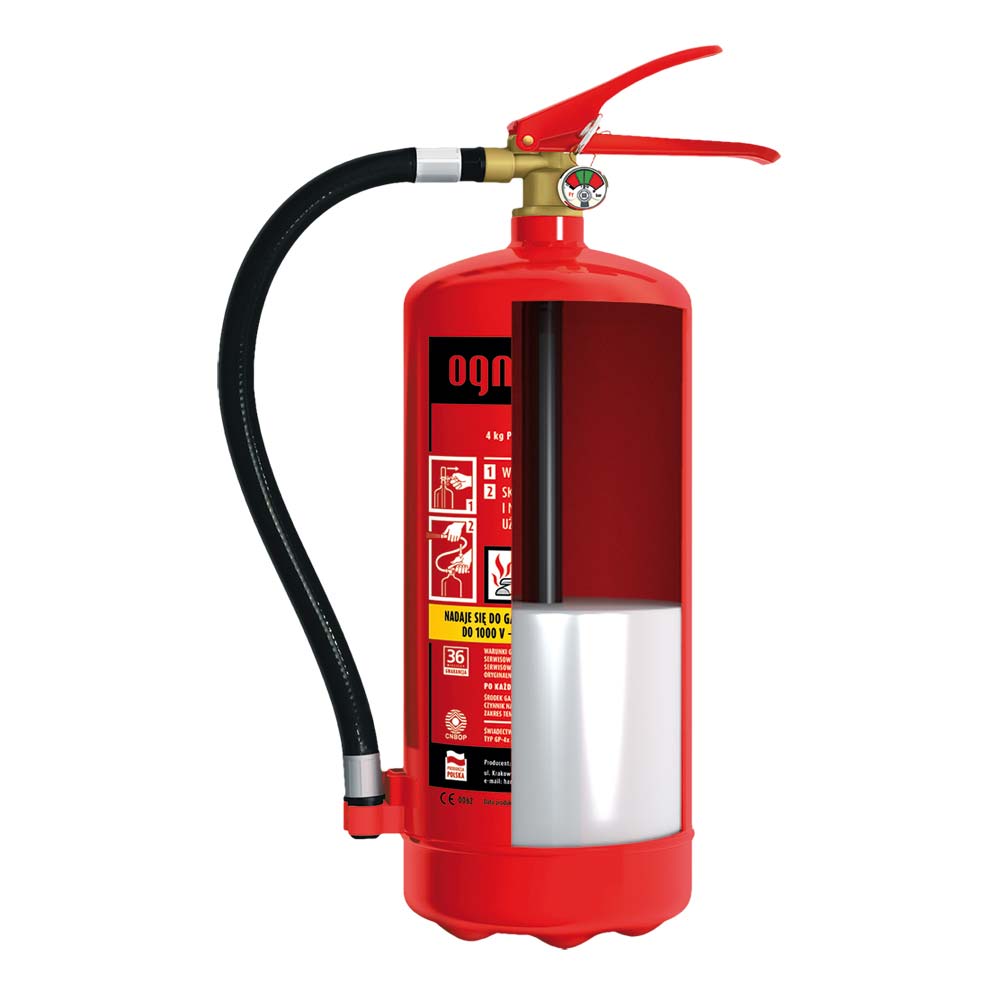
| A Upper leverB Safety pinC Outlet nozzleD HeadE IndicatorF Lower lever | G CylinderH Propellent gasI Dip tubeJ Rubber hoseK Vent, nozzle pistol |
The construction of the fire extinguisher
The general construction of the fire extinguisher includes: a cylindrical tank with extinguishing agent, head with a levered valve (type Z with a puncture lever) and a discharge nozzle to which a rubber hose can be connected finished with a horn or a jet nozzle (containing at least 3kg, 3dm3 of extinguishing agent), siphon tube for the transportation of extinguishing agent from the tank by a propellant agent, a carrying handle, a safety pin and a seal preventing inadvertent operation.
Z type fire extinguishers often feature propellant gas cartridge and an additional tube through which the gas flows to the extinguishing agent canister after the membrane of the cartridge is punctured. X type extinguisher – at a constant pressure – are equipped with a pressure gauge enabling inspection of the pressure inside the cylinder. The pressure gauge has three scales – two at the sides painted red and one in the centre painted green. If the indicator is in the green area, it means that the pressure inside the vessel is correct. If it is in the red, it means that the pressure is either too high or too low.
The propellant agent is used to expel the extinguishing agent from the canister. Two types of inert (inflammable) gases are used for this purpose: nitrogen (N2) and carbon dioxide (CO2). Nitrogen is used mainly in X type extinguishers, i.e. those which are under permanent pressure. Carbon dioxide is used in cartridges of Z type extinguishers and as an extinguishing agent in the “snow” carbon dioxide fire extinguishers, where it is used in the form of a liquid.
Operation
To use a fire extinguisher you should first remove the seal and pull the safety pin to unlock the levered valve.
If it is an X type extinguisher, i.e. under permanent pressure, push the lever and direct the discharge nozzle at the fire. According to the standards, the discharge should start after no more than one second.
If it is a Z type extinguisher, i.e. the one with the cartridge, after you push the lever or the puncture lever in the shape of a mushroom you will have to wait 3 – 5 seconds until the gas from the cartridge mixes with the extinguishing agent and the pressure inside the canister is even.
After that time, you should start extinguishing the fire by opening the valve which cuts off the jet nozzle and directing it towards the fire. A common mistake in the operation of Z type extinguishers is opening the valve too early which means that the gas which escapes does not carry enough of the extinguishing agent.
Comparison of propellant gases commonly used in fire extinguishers
| No. | Property | Carbon dioxide CO2 | Nitrogen - N2 | |
|---|---|---|---|---|
| 1. | Colour | colourless | colourless | |
| 2. | Odor | odorless | odorless | |
| 3. | Molecular weight | 44.01 g/mol | 28.016 g/mol | |
| 4. | Temperature | melting point | -56,6 oC | -209,89 oC |
| boiling point | -78,0 oC | -195,80 oC | ||
| critical point | -31,6 oC | -147,10 oC | ||
| 5. | Critical pressure | 7,43 MPa | 3,39 MPa | |
| 6. | Density | gas | 1,976 kg/m3 | 1,2506 kg/m3 |
| compared to air | 1.529 (heavier) | 0.9673 (a little lighter) | ||
Discharge time
The minimum discharge time determines the duration of the activity of a given fire extinguisher. It depends on the extinguishing capacity and nominal extinguishing agent content of the given fire extinguisher and is specified in the PN-EN 3-7:2004+A1:2007 standard.
The discharge time is given in seconds and the operation of the fire extinguisher should be equal to or longer than that time, excluding the residue of extinguishing agent. During an inspection the content of remaining extinguishing agent is verified. It should not be higher than 10% of the entire content.
Operating pressure
The operating pressure, described as the maximum pressure at a maximum operating temperature, is a very important technical and operational parameter which provides information on the pressure at which the fire extinguisher should work in an inactive mode and after use (depending on its type) and what is the danger of incorrect use, e.g. when the fire extinguisher is exposed to the activity of heat which may increase the pressure inside the cylinder.
The pressure is measured when the fire extinguisher is stable (during a time of at least 24 hours) at a maximum acceptable temperature which is 60°C. In case of fire extinguishers with a cartridge, the maximum pressure is the value registered over 0.5s during a time of 3 minutes, excluding 1s after the propellant gas is released.
Operating temperature range
These are the maximum and minimum temperatures at which the fire extinguisher will work efficiently. According to PN-EN 3-7:2004+A1:2007 for all types of extinguishers, with the exception of water type fire extinguishers, these temperatures are from -20°C, -30°C or lower (Tmin) to + 60°C (Tmax). In case of water type fire extinguishers Tmax is the same, however, Tmin depends on the addition of antifreeze substances. If the extinguishing agent does not contain antifreeze substances, Tmin is +5°C.
If the extinguishing agent contains antifreeze additives, Tmin will depend on the number of degrees Celsius by which these substances lower the freezing point of the agent. In such a case Tmin is from 0 to even -30°C.
Weight of the fire extinguisher and extinguishing agent
In terms of the possibility of transportation of extinguishers and optimum use of the extinguishing agent content an important parameter is the weight of the fire extinguisher and the weight of extinguishing agent. The weight includes the fire extinguisher, the agent and equipment (ready to be used).
Electrical fire extinguishing
For administrators of buildings where on-hand fire protection equipment is required, the information on the label about the limitations and safety of extinguishing electrical fires is very important. It informs users if the given extinguisher is suitable for the extinction of an electrical fire or not.
Propellant agents and their properties
The technical specifications of a given fire extinguisher contain the type of applied propellant agent and, if it is in a separate container, its weight in grams.
The gases which are usually used for this purpose are nitrogen and carbon dioxide. The PN-EN 3-7:2004+A1:2007 standard allows the use of air, argon and helium. All of them, apart from the air, are inert, extinguishing gases (they push oxygen outside the fire zone and lower its concentration) which support the activity of expelled extinguishing agent.
They are also used in mixtures of inert gases, such as Argonite, Inergen or as a homogenous agent. The properties of the two most common propellant gases N2 and CO2 are presented in the table: “A comparison of the properties of propellant gases commonly used in fire extinguishers”.
You should remember that these gases may be toxic in high concentration. In enclosed spaces they lower the concentration of oxygen and if their content in the air is high they may have suffocating or sometimes narcotic effects. The most dangerous among them is carbon dioxide which has slightly narcotic effect and may irritate the skin or mucous membranes.
All construction elements and agents used in fire extinguishers are subject to tests in accordance with the provisions of standards and regulations. The same applies to the above mentioned technical and operational parameters which are significant to the users of fire extinguishers, fire protection and OSH instructors, administrators of buildings where such equipment is required by law.
Floating pumps
Floating pumps posiadają szerokie zastosowanie w służbach ratowniczych. Obok głównej grupy odbiorców – strażaków, cieszą się również wysokim uznaniem wśród pracowników służb komunalnych, leśnych, budowlanych – wszędzie tam gdzie zachodzi konieczność pompowania wody.
Small size and high efficiency of the pump make it an ideal solution in emergency situations, when time and work efficiency are key factors.
Combustion engine enables the pump to be used in any place, without the need to access electricity. Floating pumps may be used to fill the cisterns of fire vehicles without the need to construct a water supply point, or to irrigate or drain agricultural lands. Considerable lifting height enables the pumps to be used on various land surfaces.
http://pl.wikipedia.org/wiki/Gaśnica, http://www.ciop.pl/5604.html, http://www.ciop.pl/26402, http://www.ciop.pl/26748, http://www.ciop.pl/27553, http://www.ciop.pl/16094.html, http://www.malopolskie.pl/Pliki/2005/Zasady_gaszenia_pozarow.pdf, http://www.interpoz.republika.pl/info.html
Shelf life
According to the applicable regulations and as a result of the technical and operational parameters of fire extinguishers they have to be inspected and, if necessary, repaired (powder replacement after, e.g. 5 years) on a periodic basis. Polish law does not provide guidelines at to the shelf life of fire extinguishers. The shelf life depends on factors such as the location of the fire extinguisher.
List of standards for fire extinguishers
PN-EN 3-7
Portable fire extinguishers - Part 7: Characteristics, performance requirements and test methods.
The standard specifies the characteristics, performance requirements and test methods for portable fire extinguishers. It establishes 17 terms and provides their definitions.
PN-EN 3-8
Portable fire extinguishers - Part 8: Additional requirements to EN 3-7 for the construction, resistance to pressure and mechanical tests of extinguishers with a maximum operating pressure of 30bar or lower.
The standard contains the rules concerning the construction, type tests, production and inspections of portable fire extinguishers with metal cisterns, depending on the pressure. It concerns portable fire extinguishers for which the maximum PS pressure is equal or lower than 30bar and which do not contain explosive, flammable, toxic or oxidizing gases. The standard also concerns a metal cartridge with 0.12l of gas and provides practical information on metal cartridges with gas of a volume larger than 0.12l but smaller than 0.5l. The standard does not apply to carbon dioxide extinguishers.
PN-EN 3-9
Portable fire extinguishers - Part 9: Additional requirements to EN 3-7 for pressure resistance of CO2 extinguishers.
The standard contains guidelines as to the design, installation, inspection and testing of portable CO2 fire extinguishers, depending on the pressure. It provides a classification of various elements of portable extinguishers.
PN-EN 3-10
Portable fire extinguishers - Part 10: Provisions for evaluating the conformity of a portable fire extinguisher to EN 3-7.
The standard specifies minimum requirements for evaluation of the conformity of fire extinguishers according to EN 3-7 and requirements for the quality control of production processes. This standard contains a list of required documentation and methods of tests, production plant evaluation and quality controls during production.
PN-EN 1866
Mobile fire extinguishers.
The standard specifies properties, rating values and division of mobile fire extinguishers and appropriate test methods. The standard concerns mobile water and powder type fire extinguishers whose weight exceeds 20kg. It establishes 18 terms and provides their definitions.
PN-EN 1869
Fire blankets.
The standard specifies the requirements concerning construction, extinguishing properties and marking of fire blankets. It also describes test methods.
PN-EN12100 (supersedes PN-EN292-1, PN-EN292-2)
Safety of machinery. General principles for design. Risk assessment and reduction.
PN-EN292-1
Machines. Safety. Basic concepts, general principles for design. Basic terminology, methodology.
PN-EN292-2
Machines. Safety. Basic concepts, general principles for design - Part 2: Technical specifications and requirements.
Requirements for fire extinguishers in facilities
The choice and location of fire safety equipment are very important elements of fire protection. Fire extinguishing equipment should be provided in amounts adequate to the given area, i.e. properties, the presence of flammable materials. You should take into account factors such as accessibility, convenient use, the ability of the staff to operate the equipment, as well as the safety of the chemicals used in the equipment.
The value of fire load density (Qd) helps to determine the size of the surface which should be protected with adequate amount of extinguishing agent.
Safety signs
Correct marking at the workplace and indication of escape routes are very important factors in ensuring the safety at the workplace.
Photoluminescent signs which we offer are manufactured according to two different technologies with the use of 11 different materials.
The signs comply with Polish regulations which is confirmed by CNBOP (Centrum Naukowo-Badawcze Ochrony Przeciwpożarowej) certification.
We also offer safety signs which comply with the following standards:
- evacuation signs according to PN-92/N-01256/02,
- fire safety signs according to PN-92/N-01256/01,
- technical fire safety measures according to PN-97/N-01256/04,
- OSH signs according to PN-93/N-01256/03,
- electrical warning signs according to PN-88/E-08501,
- chemical warning signs and signs concerning pipelines PN-70/N-01270,
- carriage of dangerous goods signs (ADR),
- marine signs according to ISO 17631,
- natural disaster signs according to PN-N-01257.
- Depending on the application and location, warning signs are manufactured on materials such as:
- adhesive foil,
- foil and PVC (various thickness),
- magnetic foil,
- aluminum.
All materials comply with the requirements of PN-92/N-01256 standard. The production technology involves the use of high efficiency luminophores which manifest luminescence for a long time to the limit value and are resistant to the external environment.
If there are potential risks, information signs are important in ensuring the safety on the road and at the workplace.
Additional safety elements on the road include:
- safety tapes,
- traffic cones,
- traffic warning lights and others.
Classes of photoluminescent signs
Photoluminescence properties according to ISO 17398.
| CLASS | after 2 min.(mcd/m2) | after 10 min.(mcd/m2) | after 30 min.(mcd/m2) | after 60 min.(mcd/m2) |
|---|---|---|---|---|
| A | 108 | 23 | 7 | 3 |
| B | 210 | 50 | 14 | 7 |
| C | 690 | 140 | 45 | 20 |
| D | 1100 | 260 | 85 | 35 |
Standard photoluminescent signs are available in class A and B. For specific purposes class C and D signs are used.
Types of materials
Signs on photoluminescent materials:
CATEGORY A
- PLA - White plate
- PSA - White plate, self-adhesive
CATEGORY B
- PL - Yellow plate
- PLS - Yellow plate, self-adhesive
Signs with a photoluminescent print:
- FS - Self-adhesive foil
- PT - PVC plate
- PS - PVC plate, self-adhesive
- LP - LUX plate
- AL - Aluminum
Standard signs:
- F - Self-adhesive foil
- P - PVC plate
- A - Aluminum sheet metal
- B - Steel sheet metal
List of standards - Signs
BS3143
Road danger lamps. The third part concerns low intensity battery powered lamps. The fourth part concerns high intensity battery powered lamps.
This British standard defines parameters, requirements and guidelines for road danger lamps.
BS873
Road traffic signs and internally illuminated bollards. Test methods.
This British standard defines parameters, requirements and guidelines for road signs and other elements of road signing.
EN12352
Traffic control equipment. Warning and safety light devices.
The standard specifies requirements concerning electrical light devices, i.e. the so-called safety lights which emit continuous or intermittent one-colour light used to warn, inform or direct road users. The standard specifies the requirements for external appearance, construction, operation and describes test methods.
The standard does not apply to devices which provide additional information (e.g. signs whose content changes) or such which indicate mandatory actions (e.g. traffic lights) or such which are covered in standards concerning conveyance lighting.
EN13422
Vertical road signs - portable, deformable warning devices. Portable road signs. Cones and cylinders.
This standard specifies the requirements for retroreflective traffic cones and cylinders. It also describes minimum visual requirements and technical properties.
EN12899-1
Fixed vertical road traffic signs. Fixed signs.
The standard specifies requirements for new fixed road signs:
- Non-reflective and retroreflective signs,
- Illuminated at night by external sources of light,
- Internally illuminated signs.
The standard defines requirements and classes of road sign plates, in the case of fixed signs, supporting construction and external lighting. It specifies colorimetric and retroreflective properties, as well as the luminance of illuminated signs.
First aid kits
There are appropriate standards which define the requirements concerning the contents of first aid kits.
Shelf life
Each product inside a first aid kit must feature a batch number, date of production and expiration date in case of sterile products (full 5 years). The label of the first aid kit contains an expiration date of sterile products (the same as on the individual products inside the kit) and the date of production of the entire kit or a refill.
The date of production of the kit is earlier than the date of production of the refill. This is why the date on the label of the kit does not show full five years.
Gas detectors
Gas detectors are devices for determining (detecting) gases and optionally registration. Gas detectors can be single-gas or multi-gas. Depending on needs, the detectors can detect gases such as eg. oxygen, carbon monoxide, hydrogen sulfide, ammonia, chlorine dioxide, nitrogen dioxide or sulfur dioxide.
Gas detectors are used in workplaces where it is necessary to continuously monitor the concentration of individual gases to warn when the concentration reaches a dangerous value.
List of standards
DIN13157
This refill completes the content of a first aid kit. It contains basic first aid equipment required by EU standards.
The first aid kit contains:
- 1 x adhesive tape 500cm x 2.5cm,
- 8 x adhesive bandage 6cm x 10cm,
- adhesive bandage kit, 4 types,
- 1 x bandage with a pad 6cm x 8cm,
- 3 x bandage with a pad 8cm x 10cm,
- 1 x bandage with a pad 10cm x 12cm,
- 1 x dressing cloth 60cm x 80cm,
- 6 x wound pad 10cm x 10cm,
- 2 x eye pad 5cm x 7.5cm,
- 1 x cold pad,
- 1 x space blanket 210cm x 160cm,
- 2 x elastic bandage 400cm x 6cm,
- 2 x elastic bandage 400cm x 8cm,
- 2 x triangular bandage 96cm x 96cm x 136cm,
- 1 x scissors 19.5cm,
- 5 x cloth made of interlining fabric 20cm x 30cm,
- 2 x foil bag 30cm x 40cm,
- 4 x vinyl gloves,
- “Emergency first aid” instructions and 1 x list of contents.
DIN13164
This refill completes the content of a first aid kit. It contains basic first aid equipment required by EU standards.
The first aid kit contains:
- 8 x adhesive bandage 6cm x 10cm,
- 1 x adhesive tape 500cm x 2.5cm,
- 2 x elastic bandage 400cm x 6cm,
- 3 x elastic bandage 400cm x 8cm,
- 2 x vinyl gloves,
- 1 x dressing cloth 60cm x 80cm,
- 2 x dressing cloth 60cm x 40cm,
- 3 x bandage with a pad (individual first aid dressing) 8cm x 10cm,
- 1 x bandage with a pad (individual first aid dressing) 10cm x 12cm,
- 6 x gauze pad 10cm x 10cm,
- 2 x triangular bandage 96cm x 96cm x 136cm,
- 1 x space blanket 160cm x 210cm,
- 1 x scissors 14.5cm,
- first aid instructions.
Najprawdopodobniej wystąpił błąd. Wygląda na to, że twoja przeglądarka nie spełnia standardów wymaganych przez tą aplikację. Prosimy o aktualizację do nowszej wersji lub użycie innej przeglądarki!
Kompatybilne wersje przeglądarek: Internet Explorer 9+, Mozilla Firefox 24+, Google Chrome 29+, Opera 21+ oraz inne nowoczesne przeglądarki wspierające technologię HTML5.
Zalecamy korzystanie zawsze z najnowszych, w pełni zaktualizowanych wersji przeglądarek!
Nie masz zgodnej przeglądarki? Poniżej znajdziesz linki do instalatorów najbardziej popularnych i zalecanych przeglądarek:
pobierz Mozilla Firefox pobierz Google Chrome pobierz Opera
There was an error. Most likely, your browser does not meet the standards required by the application. Please upgrade to a newer version or use a different browser!
Compatible browsers: Internet Explorer 9 +, Mozilla Firefox 24 +, Chrome 29 +, Opera 21 + and other modern browsers support HTML5 technology.
We recommend that you always use the latest, fully updated versions of supported browsers!
No compatible browser? Below you will find links to the installers of the most popular and recommended browsers:
download Mozilla Firefox download Google Chrome download Opera
Произошла ошибка. Скорее всего, ваш браузер не соответствует стандартам, требуемым приложением. Обновите версию до новой версии или используйте другой браузер!
Совместимые браузеры: Internet Explorer 9 +, Mozilla Firefox 24 +, Chrome 29 +, Opera 21 + и другие современные браузеры поддерживают технологию HTML5.
Мы рекомендуем всегда использовать новейшие, полностью обновленные версии поддерживаемых браузеров!
Совместимый браузер отсутствует Ниже вы найдете ссылки на инсталляторы самых популярных и рекомендуемых браузеров:
загрузить Mozilla Firefox загрузить Google Chrome загрузить Opera
Es ist ein Fehler aufgetreten . Höchstwahrscheinlich entspricht Ihr Browser nicht den von der Anwendung geforderten Standards. Bitte aktualisieren Sie auf eine neuere Version oder verwenden Sie einen anderen Browser!
Kompatible Browser: Internet Explorer 9 +, Mozilla Firefox 24 +, Chrome 29 +, Opera 21+ und andere moderne Browser unterstützen die HTML5-Technologie.
Wir empfehlen, immer die neuesten, vollständig aktualisierten Versionen der unterstützten Browser zu verwenden!
Kein kompatibler Browser? Unten finden Sie Links zu den Installern der beliebtesten und empfohlenen Browser:
Mozilla Firefox herunterladen Google Chrome herunterladen Opera herunterladen
( Niezalecane, chyba, że jesteś pewna/pewien, że twoja przeglądarka spełnia wymagane standardy / Not recommended unless you are certain that the web browser meets the required standards / Не рекомендуется, если вы не уверены, что веб-браузер соответствует требуемым стандартам / Nicht empfohlen, es sei denn, Sie sind sicher, dass der Webbrowser die erforderlichen Standards erfüllt )